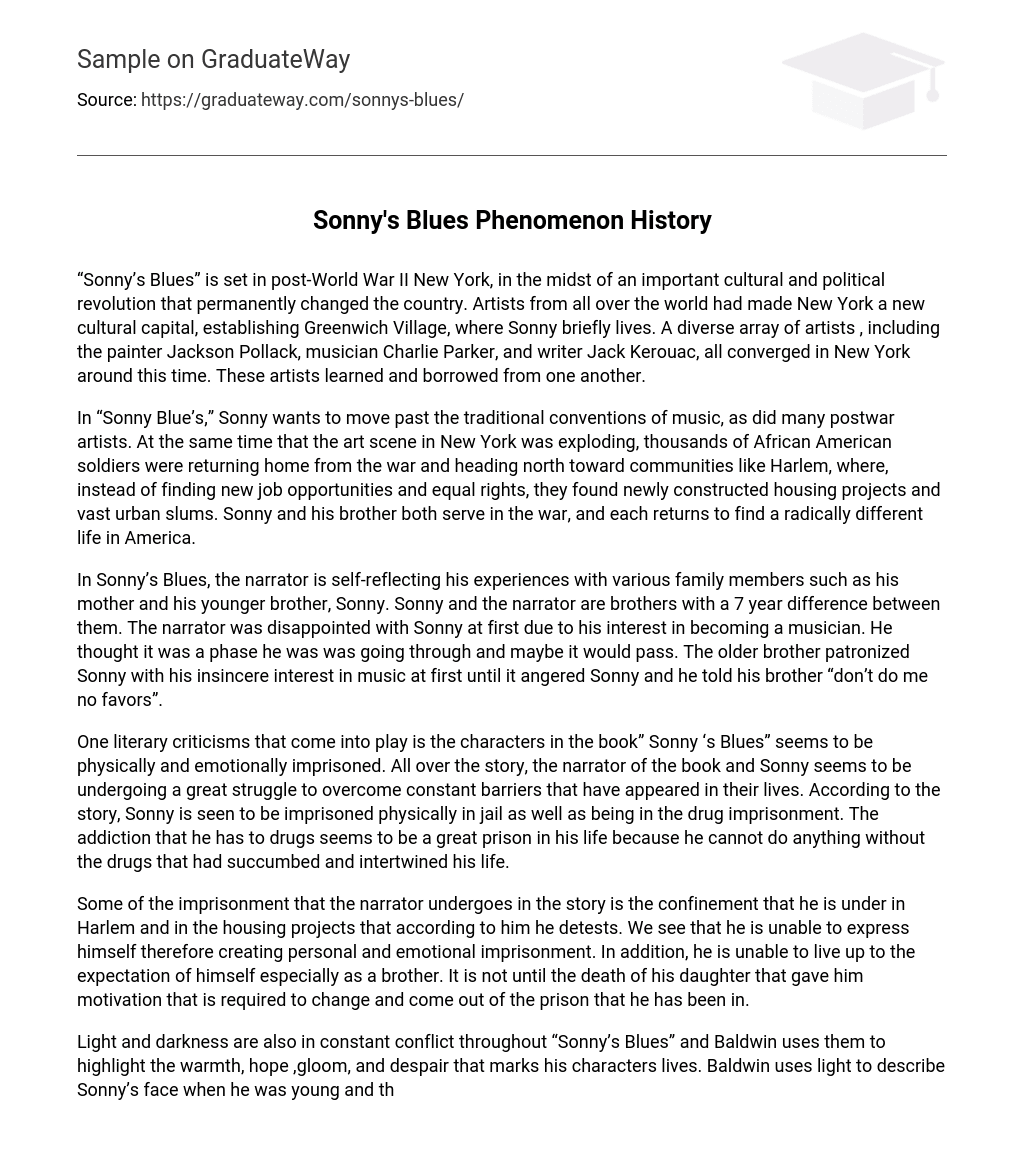The setting of “Sonny’s Blues” is in post-World War II New York during a significant cultural and political revolution that had a lasting impact on the country. New York became a fresh cultural hub attracting artists from various parts of the world. Greenwich Village, where Sonny briefly resides, was at the center of this cultural transformation. Notable figures like painter Jackson Pollack, musician Charlie Parker, and writer Jack Kerouac were among the many artists who gathered in New York during this period. They shared knowledge and borrowed ideas from one another.
In “Sonny Blue’s,” Sonny desires to surpass the conventional norms of music, similarly to numerous postwar artists. Simultaneously, during the period when the art scene in New York was flourishing, a large number of African American soldiers were coming back from the war and migrating northwards to places like Harlem. However, instead of encountering new employment prospects and equal rights, they discovered recently built housing projects and enormous urban slums in these communities. Sonny and his brother both served in the war and upon returning, they discover a drastically transformed life in America.
In “Sonny’s Blues,” the narrator reflects on his experiences with his mother and younger brother, Sonny, who are both important figures in his life. Despite a 7-year age difference, the narrator initially felt disappointed with Sonny’s decision to pursue music, dismissing it as a passing phase. Initially, the older brother’s interest in Sonny’s music was insincere, which eventually angered Sonny to the point where he asked his brother not to feign support.
One literary criticism that arises in the book “Sonny’s Blues” is the depiction of characters as being both physically and emotionally imprisoned. Throughout the story, the narrator and Sonny face numerous obstacles that they must overcome. Sonny is physically imprisoned in jail, but he is also trapped in a cycle of drug addiction. This addiction acts as a metaphorical prison, as it dominates his life and prevents him from functioning without drugs.
In the story, the narrator experiences different types of confinement. He feels limited in Harlem and within the housing projects and has a strong aversion to these surroundings. This restricts his ability to express himself freely, resulting in personal and emotional imprisonment. Moreover, he encounters difficulties in meeting his own expectations, especially as a sibling. Nevertheless, it is only when he tragically loses his daughter that he finds the determination needed to escape from the prison that has kept him captive.
Within “Sonny’s Blues,” Baldwin utilizes the ongoing juxtaposition of light and darkness to emphasize the contrasting emotions and experiences that mold his characters’ lives. Light is utilized by the author to highlight Sonny’s youthful visage as well as the soothing ambiance in a room teeming with adults following a church service, thereby symbolizing optimism and potentiality in life, while also bearing religious connotations. Furthermore, light represents not only the finest attributes of existence but also serves as an emblem of redemption and divine endorsement.
Living in light represents living a moral life. There is also symbolism in the story’s ending, with the narrator describing a glass of wine on Sonny’s piano as shaking “like the very cup of trembling.” This highlights the challenging and complex situation that Sonny is in. The image is borrowed from the bible, where the cup of trembling symbolizes the suffering and fear experienced by people. The biblical passage promises relief from this suffering.
Sonny’s drinking from the cup of trembling symbolizes the hardships he has faced and also presents the opportunity for redemption and tranquility. Utilizing his musical talent, Sonny transforms his own suffering and that of others into something exquisite. The narrator finally realizes, through his own sufferings and by observing Sonny, that he is able to connect with humanity and find his place among others. It is through the shared experience of suffering that unites all individuals, and by ignoring his pain and agony, he has excluded himself from the collective community.
He had not only deprived himself of brotherhood, but also of the solace that accompanies sharing a common bond. Finally, he can experience pride in his brother’s achievements and support him in a newfound way. He is finally acting with sincerity, and his perception of his brother transforms from disapproval and disappointment in his youthful aspirations to pride in his accomplishments as both a musician and an individual.
Works Cited:
- “Sonny’s Blues” www. Troy. edu/blackboard www. ehow/how www. cai. ucdavis. edu/slecture





